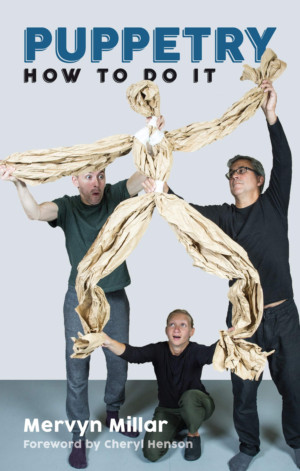Book Review: PUPPETRY: HOW TO DO IT, Mervyn Millar

Theatre and puppetry director Mervyn Millar's latest book is a practical insight into the use of puppets in theatre. Millar is incredibly well-equipped to provide this thorough guide, having been part of the creative and performing teams of the National Theatre's War Horse from the very beginning, as well as extensive puppet design and direction for the Royal Shakespeare Company, Bristol Old Vic, Schauspielhaus Zürich and many others. He's also Chair of the Puppet Centre Trust, and regularly runs teaching sessions and workshops for a range of organisations.
The book is separated into five different sections: Bringing Things to Life, Exploring the Basics, Working with Complex Objects, The Puppeteer and Puppets. In that way, it truly does start from the beginning and allows you to build up from a solid base - whether you have previous puppetry experience or are coming in as a blank canvas. You also don't need to worry about having any puppets to hand, or making puppets yourself, as the exercises generally only require simple objects such as sticks and paper; it really does just focus in on the goal of instilling puppetry skills, rather than overcomplicating matters.
In terms of getting practical use out of it, the book reads best if you are intending on running a puppetry workshop (or perhaps a rehearsal session), as the many exercises give instructions that are as much puppetry teaching guides as puppetry lessons in themselves. These exercises are laid out very clearly, set apart in shaded boxes with very easy to follow steps. They range from the straightforward (simply using hands to really get to grips with the idea of making puppets 'breathe') to the more complex (several puppeteers working together to operate one larger puppet), each skill being built upon as you progress through the chapter.
You don't, however, have to rigidly go through every single exercise and chapter in order - you should feel free to pick and choose exercises depending on your specific needs. For example, it may be beneficial to take newbies through more of the exercises exploring the basics, whereas for more proficient puppeteers perhaps just one of these activities will suffice before moving onto something more complex. Millar is keen to stress this at various points in the book; from his own experiences, he's found things that work particularly well, but recognises that different people have different styles and needs.
Whilst it is mostly a book for puppeteers to use learn about puppetry or enhance their skills, it's also an eye-opening read for non-puppeteers as you gain an insight into how it all works - and appreciate the puppeteers' graft and effort all the more. It's an invaluable resource for directors and designers, as it gives a good idea of what may or may not be possible in a production, as well as the benefits puppets can bring. Critics and other theatregoers, too, could definitely take a lot out of particular sections of the book.
Millar's obvious enthusiasm for puppetry leaps off the page and could convert even the most ardent puppet skeptic of the value of the art form. It's an absolute must for anyone with even the slightest interest in taking up puppetry - or even teaching it themselves.
Puppetry: How to Do It by Mervyn Millar (Nick Hern Books, £14.99) is available now
Picture credit: Nick Arthur Daniel
Reader Reviews
Videos

